




Chelsea Book Fair. 1st and 2nd November 2024
Chelsea Old Town Hall, King’s Road, London SW3 5EE
Beautifully bound Vale Press poetry
1. SUCKLING, Sir John [ed. John Gray] The Poems of Sir John Suckling

London: Sold by Messrs. Hacon & Ricketts at the sign of the Dial. 1896 Limited edition (one of 310 copies), described thus in the colophon: “This Edition of the Poems and Songs of Sir John Suckling, edited by John Gray and decorated with Woodcut Border and Initials by Charles Ricketts, under whose Supervision the Book has been printed by the Ballantyne Press.” Octavo in 4s. pp. [ii], cxvii. Red morocco, attractively decorated in gilt with leaf and flower motifs and lettered in gilt to the spine. Turn ins decorated in gilt, marbled endpapers. Although unsigned, the binding has some of the characteristics of the work of C.E.Gladstone whose work is found on other books produced by Ricketts’s Vale Press. Slight rubbing to the joints and some marking to the edges of the boards. Minor spotting to the fore-edge but otherwise a very good copy and a nice example of the work of the short lived Vale Press.
[4366]
£850
“the English nation always surpassed the French” . Erasmus and More’s printer.
2. [WINGFIELD, Sir Robert] Nobilissima Disceptatio super dignitate et magnitudine Regnorum Britannici et Gallici habita ab utriusque oratoribus et legatis in concilio Constantiensi

Leuven: Theodoricus Martinus (Dirk or Thierry Martens). 1517
First edition, small quarto 188x130mm. Unpaginated, ff.26, a-e4, f6. Lacking c4 which has been supplied in manuscript in the nineteenth century. Some contemporary marginal annotations in ink and two later ones in pencil. Bound in nineteenth century quarter calf, marbled paper covered boards. Spine chipped and worn with about one inch of the binding missing. Corners and edges rubbed and worn. Internally, waterstaining to leaves f5 and f6 and an ink mark on the verso of f4 and recto of f5 but otherwise a very good copy. USTC locates copies in four UK institutions, two in France and one in Denmark. Only the Colbert copy appears in the auction records.
Sir Robert Wingfield (1464-1539) was a diplomat from the distinguished Suffolk family who served the courts of Edward IV and Henry VII. In 1510, Sir Robert was appointed to be the English Ambassador to Emperor Maximilian I in which role he was preoccupied with attempts to secure an alliance against France. ODNB describes this period thus: “During his seven-year embassy Sir Robert became a good if too trusting friend of the emperor, and perhaps in consequence remained fiercely anti-French throughout his life”. Anglo-French spikiness is the subject of Nobilissima Disceptatio. Ostensibly the book is an account of the debates at the Council of Constance (1414-18) at which France objected to the presence of the English on the grounds that England was an insufficiently important nation. Wingfield used the preface to Nobilissima Disceptatio to note that “whether in arms or in faith ... the English nation always surpassed the French, nor could it be judged inferior in the dignity and antiquity of its inhabitants, the size and greatness of its lands, or the character and learning of its people”. So, not for the first time and certainly not for the last, the recounting of AngloFrench history descended into polemical point-scoring.
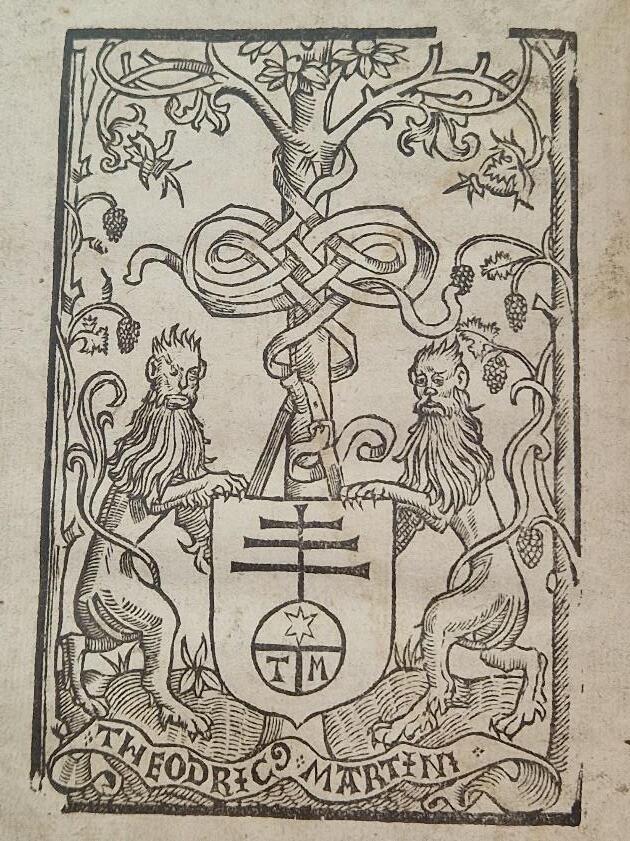
Among the many people Wingfield met during his time as Ambassador was Erasmus, through whom, perhaps, he met Dirk Martens who, as well as printing more than fifty of the great scholar’s works, had, in 1516 printed the first edition (in Latin) of Thomas More’s Utopia. More and Erasmus’s eirenicism may have been alien to the combative Wingfield but the Martens imprint ties this little book to the mainstream of Renaissance humanist culture.
[4365]
3. BELL, Currer [Brontë, Charlotte] Jane Eyre: An Autobiography
Leipzig: Bernh. Tauchnitz Jun. 1848
£1,750

First continental European edition. 8vo. 148x115mm. pp. iii-x, 1-342; 1-340. With two gift inscriptions on the front free endpaper dated 1850 and 1880. Bound in contemporary red morocco without the half-titles and the title page to volume II. Gilt border to upper and lower covers, spine lettered in gilt. All edges gilt. Spine slightly faded, extremities a little rubbed and with the usual foxing of these Tauchnitz editions but overall a very good copy of the first continental edition published the year after the first edition in England and the same year as the first American edition. It includes the preface to the second English edition published in December 1847. Jane Eyre was an immediate success for Tauchnitz with a second edition following two years later and the publishers securing the rights to all the other Charlotte Brontë novels as soon as they could.
Walter E. Smith pp. 49-51. [4364]
4. HESSE, Hermann Das Glasperlenspiel
Zürich: Fretz & Wasmuth. 1943
Inscribed by Hesse: “Ein Gruss für Reinhard Weiss von H. Hesse”. Two volumes. 8vo. 182x108mm. pp. 451, [1]; 441, [1]. Original pale blue cloth with HH monogram in gilt to upper covers and spine decorated in gilt with black label lettered in gilt. Original dust jackets. Spines of dustjackets browned and a little soiled with slight
£350

chipping to the foot of the jacket of volume one. Housed in a cardboard slipcase. A very nice copy. Hesse was not profligate with his inscriptions and this is an important book on which to find his signature. Rejected for publication in Germany because of the Hesse’s opposition to the National Socialist regime Das Glasperlenspiel was Hesse’s last full length novel. It is a complex utopian meditation on education, learning, psychology the relationship between intellectuals and society. Three years after its publication, Hesse was awarded the Nobel Prize for Literature.
[4367]
£950

Rare presentation copy of the first appearance of Biord’s letters to Voltaire.
5. BIORD, Jean-Pierre and Voltaire Correspondance de Monseigneur L’Évéque et Prince de Geneve, avec Mr de Voltaire. n.p. n.p. n.d. [1769]
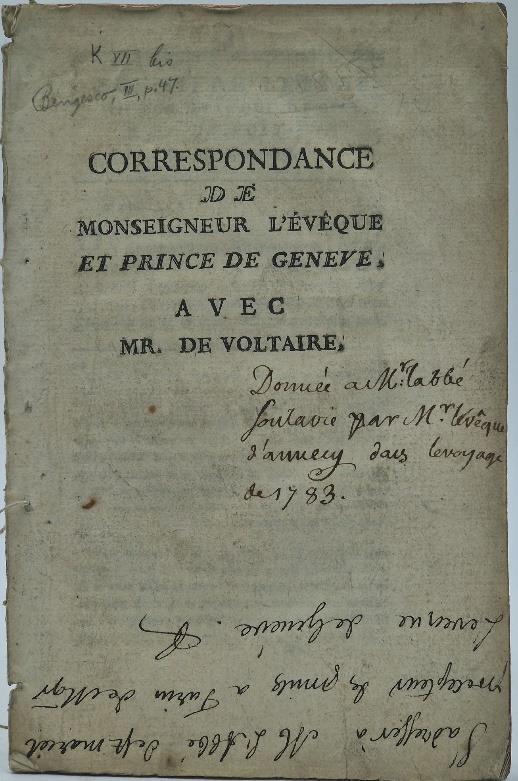
Presentation copy from the author to Jean-Louis Giraud-Soulavie. 8vo. 189x123mm. pp. 32. This little pamphlet contains five letters from Jean-Pierre Biord, the Prince-Bishop of Geneva to Voltaire, two letters from Voltaire to Biord and a short recollection by Voltaire in relation to one of Biord’s letters. On the title page is inscribed “Donnée a M. l’abbé Soulavie par M. l’éveque d’annecy dans le voyage de 1783”. This is from Biord himself (who was also Bishop of Annecy (which only became a separate diocese in 1822) to the geographer, geologist, natural historian, and leading figure in the French Revolution JeanLouis Giraud-Soulavie. The “voyage of 1783” referred to may well have been the journey around France made by Soulavie to investigate the effects of the eruption of the Laki volcano in Iceland which caused a mini ice-age in Europe. Worldcat locates one copy only, in the Institut et Musée Voltaire.
This little pamphlet with its inscription offers an interesting set of intellectual links on the eve of the Revolution. The correspondence between Biord and Voltaire was famously spiky. It was prompted by Voltaire’s holding of a mock Mass to mark Easter in on 3 April 1768, Biord’s first letter appearing eight days later. This is, therefore the first public appearance of the early part of the correspondence between the two men. Quite what the relationship between Biord and Soulavie was like, is hard to say. The latter would undoubtedly have been on Voltaire’s side: the year after receiving this pamphlet, the church ordered Souvlaive to renounce his geological writings. But clearly the two men struck up some sort of relationship and perhaps Biord hoped that the arguments which had failed with Voltaire might find a more sympathetic ear with Soulavie.
[4379]
£495
6. [SHUVALOV, Andrei Petrovich] A Voltaire
Amsterdam: n.p. 1779
First edition. 8vo. 190x124mm. pp. 20. Modern bluegrey wrappers, in excellent condition throughout. A very nice copy of a poetic eulogy to Voltaire. Worldcat locates six copies worldwide. Andrei Petrovich
Shuvalov was a Russian politician and soldier with links to the Imperial family. He travelled widely and became a close friend of Voltaire under whose liberal spell he fell. This poem appeared the year after Voltaire’s death in 1778 and is fulsome in its praise:
“Tu prêchas soixante ans l’heureux Tolerantisme
Les devoirs, les vertus, les lumières, la paix,
L’amour du Genre humain”
[4380]
£95

7. [LARCHER LA TOURAILLE, Jean-Chrysostome and Voltaire] Lettre de M. Le Comte de *** A M. De Voltaire, a l’occasion du nouvel an. n.p. n.p. [1768]

A letter from Jean-Chrysostome Larcher to Voltaire. 8vo. 167x116mm. pp. 7 [1bl]. Disbound. Three handwritten notes in the text. Some soiling. Rare, no copies appearing at auction and only the BNF copy recorded in Worldcat. Larcher’s mind was supple and subtle mind in an age when such a thing was dangerous. His fellow aristocrats disapproved of his friendship with the Philosophes Rousseau, Diderot and, especially Voltaire (with whom he engaged in a lengthy correspondence) but when the Revolution arrived, he was deemed a counter-revolutionary aristocrat and lost his head.
[4381]
£150
An unrecorded variant
8. HOLY BIBLE. The Holy Bible, containing the Old Testament and the New: Newly translated out of the original tongues, and with the former Translations diligently compar’d and revis’d, By his Ma[jesty’s] Special Command. Appointed to be Read in Churches London: Printed by John Baskett, printer to the King’s most Excellent Majesty, & by the Assigns of Thomas Newcomb and Henry Hills deceas’d 1715

Bound with The Book of Common Prayer, London: Charles Bill and the Executrix of Thomas Newcomb, deceased, 1709. And with The Whole Book of Psalms: Collected into English Metre by Thomas Sternhold, John Hopkins, And Others. London: Printed by J. Heptinstall, 1717. 8vo. 192x120mm. Unpaginated. Collates as follows: BCP a4, A8G6. Bible pi1, A8-Z8, As8-Zz8, Aaa8-Zzz8, Aaaa8-Cccc4. Psalms: A4-L4. General title for the Bible dated 1715 with the separate title page for the New Testament dated 1710.
Contemporary black morocco decorated with gilt panel with gilt cornerpieces. Spine lavishly decorated in gilt. Extremities and head and foot of spine rubbed and worn and a split to the joint of upper cover at head and foot of spine. Some marking and fading to covers. All edges gilt. Internally very good but with some waterstaining from Bbbb and Cccc of the New Testament.
This edition appears to be unrecorded in Herbert. The closest is Herbert 933 which has the OT dated 1715 and the NT dated 1712 but our copy has a 1710 NT printed by the Assigns of Thomas Newcomb and Henry Hills whose first Bible was in 1710 but was a 12mo with the text ending on S2a whereas this Bible collates continuously throughout the OT and NT. Baskett’s name which is on the Old Testament title page does not appear on the New Testament until the 1712 edition and so is absent here. A nice copy of an unrecorded variant.
[4383]
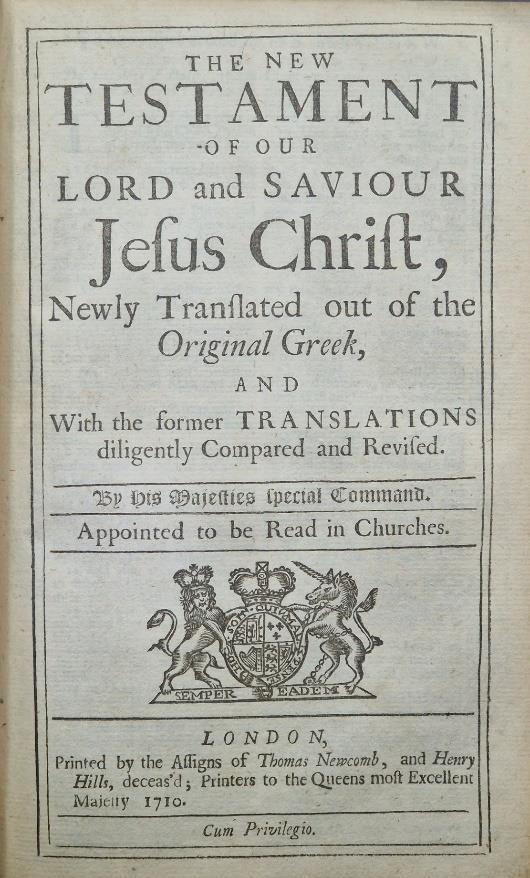
£950
“trenchant and wilfully esoteric”
9. BOWEN, Rowland The Cricket Quarterly. A Journal devoted to the noble game of cricket. Eastbourne and Mullion, Cornwall: Published by the author 1963-1970

A complete set of The Cricket Quarterly in eight volumes, bound in blue cloth, lettered in gilt to the spine. The Cricket Quarterly ran for eight years appearing every three months. Described as “trenchant and wilfully esoteric” the magazine reflected the tastes and the character of its volatile and eccentric editor, Rowland Bowen (1916-1978) whose cricketing interests were extensive - here you will find an early German- Danish account of a game and a piece on cricket in Nigeria. Articles on the history of the game ranged far more widely than in any other magazine and he had a roster of fine contributors including C.L.R.James, C.P.Snow, Neville Cardus and Irving Rosenwater. But Bowen’s tongue was sharp: his book reviews took no prisoners and he specialised in making enemies. He was clearly a strange man. In 1968, he performed a self-amputation (on his right leg, below the knee), out of curiosity and to see if it would hurt. He also believed that there was a “good case for nationalising Lord’s”. Cricket has a tendency to attract slight oddballs and few came odder than Bowen.
[4384]
On with the show: two Laura Knight circus drawings
10. KNIGHT, Laura. On with the Show
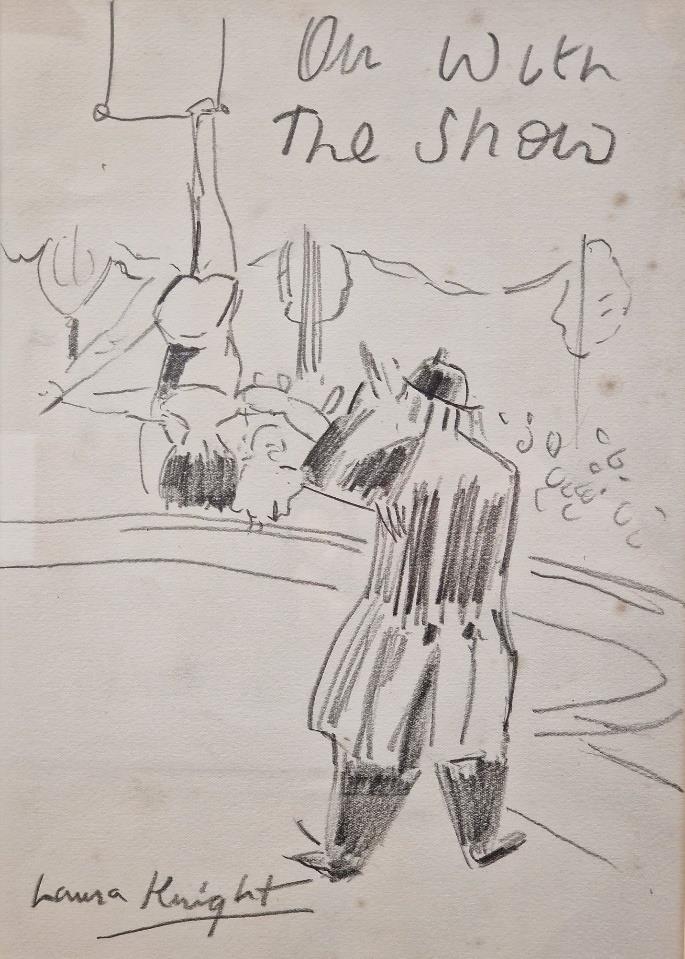
£250
A pencil drawing of a circus ringmaster and a trapeze artist hanging upside down on her trapeze. The drawing measures 275x192mm, mounted on white card and framed in black wood (406x327mm). A few spots of foxing but otherwise in excellent condition. Laura Knight was fascinated by the circus and produced many drawings on the subject. This drawing was clearly important for her as she gave it a title and it was (in 1988, long after her death) the title given to a collection of her drawings at David Messum’s Gallery. It was (printed in green) the image on the front cover of the catalogue to that exhibition.
[4385] £1,500
11. KNIGHT, Laura. Circus horse, rider and ringmaster.
A pencil drawing of a circus horse with a rider and the ringmaster standing next to it holding the rein. The drawing measures 275x192mm, mounted on white card and framed in black wood (406x327mm). One of two small spots of foxing but otherwise in immaculate condition. Laura Knight was fascinated by the circus and produced many drawings on the subject. This charming sketch captures a moment of rest and calm in the hurly-burly of an evening at the big top.
[4386]
12. HERVEY, Harry. Congaï
New York: Cosmopolitan Book Corporation. 1927
First edition. 8vo. 187x125mm. pp. [viii], 320. Original black cloth, lettered and decorated in silver. With the rare illustrated dustjacket. Some staining and marking to the cloth. The dustjacket is chipped at the top edge and to head and foot of spine and there are a small tears at the folds with the flaps which have been repaired. But this is an extremely uncommon (and very striking) dustjacket. Internally very good but with a split to the hinge with the lower cover and with some toning to the edges.
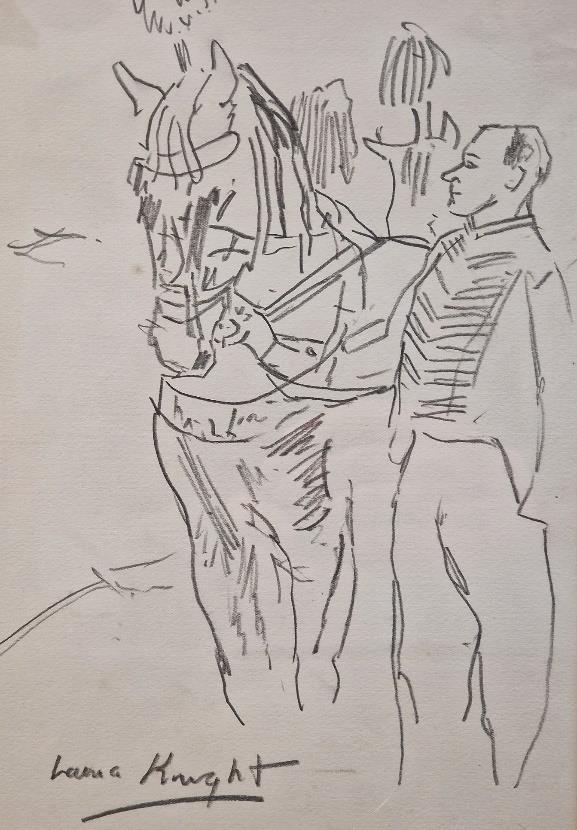

Congaï is something of a cult novel (it was reprinted in 2014). It is one of the first western novels to be set in Vietnam (Indochina), the hero is gay and travelling with his boyfriend but looking at other men through the eyes of fictional woman. It deals, with colonialism, it falls into the trap of (what was not yet called) “orientalism” in its “othering” of the sultry, sexual, opium infused East. An extraordinary novel which has been described as a “celebration of ‘fluidity’”.
[4371]
£450
“pédéraste et opiomane”
13. RENÉ, Commandant. Missions Speciales III. L’Enfer de Sodome
Givors: André Martel. 1952

First edition. Large 8vo. 202x143mm. pp. 439 [1]. In the original luridly illustrated dustjacket. Jacket with some chipping and creasing and a closed tear to the lower cover. Internally very good with some browning. Overall a very good copy of from the popular Missions Spéciales eries of pulp schlocker. L’Enfer de Sodome is set in various “exotic” locations including Tangier, Shanghai, Port-Said, Marseille, Burma, Bombay and the low-life of London and Paris. In the novel, our hero, Commandant René, is charged with hunting down and arresting the mysterious “Z-32” described only as “d’extraction asiatique - pédéraste et opiomane”. [4376]
£95
14. GOULETTE, Léon L'absinthe et l'alcool dans la défense nationale (Russie - FranceGrande-Bretagne)

Paris and Nancy: Berger-Levrault & Libraires-Éditeurs 1915
First (and apparently only) edition. 8vo. 185x118mm. pp. xii, 207 [1bl]. In original printed grey wrappers and housed in a marbled paper covered slipcase. Most of the gatherings are unopened although there is a tear to the final leaf where is has been opened. Small chip to foot of the spine and a crease to bottom edge of lower cover. Spine somewhat browned but overall a very good copy of a rare book, seemingly untraceable in commerce. It was published as part of the “Bibliothéque de la Guerre” and seeks to paint the link between heavy alcohol use and inefficiency as a danger to national security in time of war. Goulette begins his book with a study of Russia which, having prohibited the sale of strong spirits, was an example to France and Britain. Given that 1915 (the year of publication of L'absinthe et l'alcool) saw a string of almost uninterrupted disasters for Russia, Goulette’s argument is an interesting one. But his book does provide a useful insight into the monomaniacal mind.
[4368]
15. CRAFTS, Dr and Mrs Wilbur F. and Mary and Margaret W. Leitch Protection of Native Races against Intoxicants & Opium based on testimony of one hundred missionaries and travelers.
Chicago: Fleming H. Revell Company. 1900
First edition. 8vo. 197x130mm. pp. 287, [2, 1bl]. In original printed wrappers. Housed in a slip case. Some chipping, soiling and creasing to wrappers. Internally excellent and overall a very good copy. An interesting collection of eye-witness accounts from missionaries around the world describing alcohol and opium misuse. The purpose of the book was to encourage prohibition in the (mainly British) colonies and the ending of the trade in drink and opium. The tone is strongly Christian so one wonders how the authors would have responded to Our Lord’s enthusiasm, evidenced at Cana, for a glass or two.
[4369]
£250

£60
16. ROBERTS, Thelma. Red Hell. The Life of John Goode, Criminal
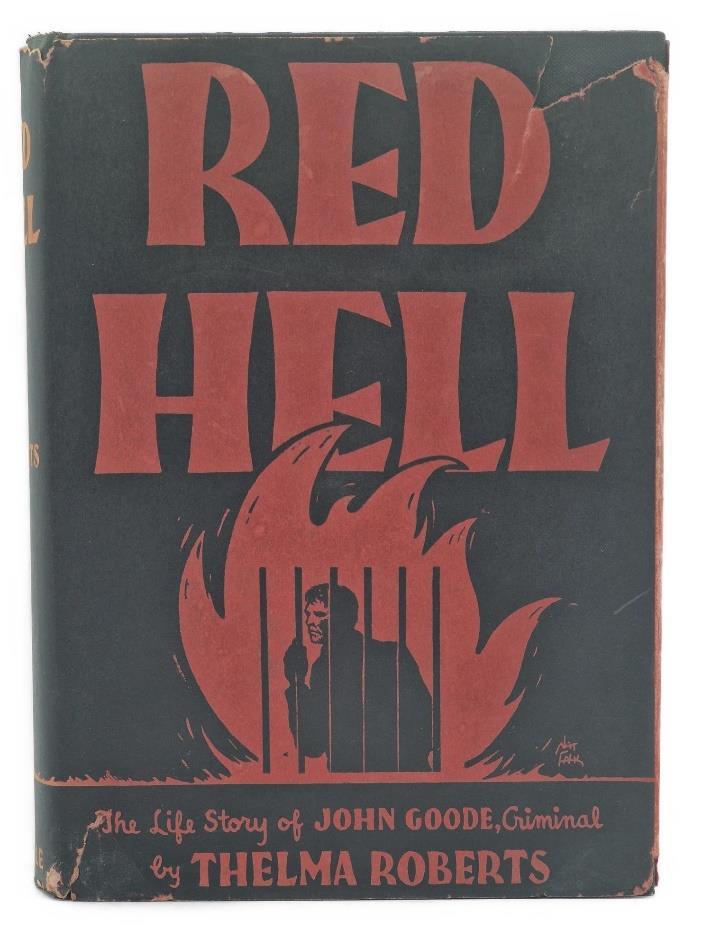
New York: Rae D. Henkle. 1934
First edition. 8vo. 200x140mm. pp. 320. Black cloth, decorated and lettered in red. Original illustrated dustjacket with a very striking design. Tear to top edge of the upper cover dustjacket with c25x15mm missing. A repaired tear and one small tear to bottom edge of the dustjacket but otherwise a very good copy and internally excellent.
Red Hell is the memoir of the career criminal John Goode (1864-1934). He was encouraged by Rae Henkle, the publisher and a friend, “to put his story into some form of written order”. Goode spent much time in prison and the book is an attempt to discourage others from falling into the Red Hell of continual crime and punishment.
[4372]
Inscribed with a letter and Christmas card
17. POWELL, Ida F. A Master of Destiny. Victor Tremaine

Boston: Chapman & Grimes 1939
£275

First edition. 8vo. 196x135mm. pp. 255 [1bl]. Publisher’s blue cloth and original dustjacket. Some closed tears to the jacket and there is a handwritten alteration to a printed address on the lower cover. Inscribed “To Mr Fred E. Mason from Ida F. Powell Author. Christmas 1941”. Loosely inserted is a two page letter and a Christmas Card from Powell to Mason. In the letter, Powell describes the book as a “romance...while the details of the detective theme is founded upon actual knowledge of facts which I gathered by contacting the police”. The hero of the novel is Victor Tremaine, a U.S. International Drug Inspector and the book is described as a “thrilling account of the dangerous work of Uncle Sam’s secret agents in tracking down dealers in marijuana, cocaine, and other debasing drugs”.
[4373]
£125
18. GATES, H.L. The Devil's Lady
New York: The Macaulay Company. 1933
First edition. 8vo. 189x126mm. pp. [8], 9-283 [1bl]. Yellow cloth illustrated and lettered in red. Original illustrated dustjacket, chipped and creased in places and with the spine a little faded but overall in very good condition. Internally excellent. An “exotic drama of passion and intrigue” about Fanya “a mandarin whose river junks carry contraband arms, a famous dealer in drugs, a Javanese dancer, a renegade aviator, a powder salesman posing as a card sharp, a Russian secret agent, adventurers and adventuresses of all sorts and nations - and Captain “Flips” Guerin, American attache, hopelessly sunk in his love for the inaccessible Fanya”. Blimey. Rare though.
[4375]

£140

19. BLACK, Winifred Dope. The Story of the Living Dead
New York: Star Company 1928
First edition. 8vo, 196x124mm. pp. viii, [4], 104. Publisher’s black cloth, lettered in yellow. Original dustjacket. Rubbing to extremities. Dustjacket has some chipping to edges, a small hole in the spine and some soiling to spine and a tear on the lower cover with c30x20mm missing. A book about drug addiction. A sensationalist book by a pioneering female journalist who covered numerous important stories for William Randolph Hearst, riding the wave of “yellow journalism”.
[4374]
£95
20. BOLDREWOOD, Rolf. The Last Chance. A Tale of the Golden West
London: Macmillan and Co., Limited. 1905
First edition. 8vo. 190x125mm. pp. [iv], 461, [1bl, 10 adverts]. Original blue cloth, upper cover decorated in blind and lettered in gilt. Slight rubbing to extremities and mild toning internally but otherwise in excellent condition throughout. Protected by a plastic transparent wrapper. Rare in commerce, only five copies appearing in the auction records in the last century.

Rolf Boldrewood is the pseudonym of Thomas Alexander Browne (1826-1915). Although born in London, he was largely brought up in Australia where he father, a shipmaster, had moved with the family in 1831 after delivering a cargo of convicts to Tasmania. Browne was a magistrate and a government official in the mining industry and took up writing when laid up after a riding accident. He adopted his nom de plume in 1884 taking the name Boldrewood from his favourite author, Walter Scott. Best known for the three volume Robbery Under Arms, Boldrewood wrote sixteen novels. Most of these began life in serial form in Australian magazines and whilst they rely, in part, on the tropes of exotic and romanticised adventure stories, they are today, regarded as authentic recreations of the hard life of bushmen, miners and convicts in mid nineteenth century Australia. The Last Chance is Boldrewood’s final novel and is set in a gold mining community.
[4377]
21. PARRY, Ernest J. The Chemistry of Essential Oils and Artificial Perfumes.

London: Scott, Greenwood and Son 1918
£75

Two volumes. Third edition, revised and enlarged. Large 8vo, 248x154mm. pp. xi [i], 521, [3]; [viii], 344. Original green cloth, lettered in black. Bumping to head and foot of spines with some very small tears. Some slight marking in places and rubbing to joints. Internally very good but with some slight loosening to the hinges in volume two. This second volume has the signature of “O. Silberrad”, one of the leading chemists of the twentieth century, a specialist in explosives and the founder of the Silberrad Research Laboratories.
[4370]
£175